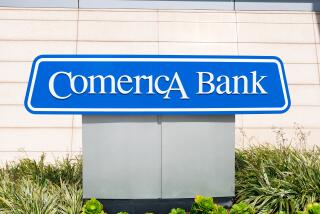Nearly all top U.S. banks could withstand severe recession, Fed says
- Share via
WASHINGTON -- Only one of the nation’s 30 largest banks would not be able to withstand a severe recession and the firms collectively are in better financial position to handle economic shocks than five years ago, according to Federal Reserve stress test results released Thursday.
Under the most extreme of three economic scenarios, Zions Bancorporation of Salt Lake City would be the only large bank at risk of failure because a key measure of financial strength would fall below the Fed’s standard.
The Fed conducts two rounds of stress tests and next week will give what amounts to pass/fail grades for the banks after factoring in each firm’s plans for dividend payments or stock buybacks this year.
PHOTOS: Federal Reserve chairs through the years
“The annual stress test is one of the Federal Reserve’s most important tools to gauge the resiliency of the financial sector and to help ensure that the largest firms have strong capital positions,” said Fed. Gov. Daniel K. Tarullo, who oversees the central bank’s regulatory functions.
“Each year we are making substantial improvements, which have helped make the process even stronger than when we first conducted the stress tests in the midst of the financial crisis five years ago,” he said.
The banks have a combined $13.5 trillion in assets, nearly 80% of the U.S. industry.
Under the Fed’s severely adverse economic scenario, those 30 firms would lose about $501 billion over 27 months.
That scenario, designed to replicate a downturn similar to the 2008 financial crisis and Great Recession, involves a sharp rise in the unemployment rate to 11.25%, a 25% decline in home prices and a nearly 50% drop in the stock market.
Under such conditions, Zions would fall below a Fed gauge of bank health. The firm’s ratio of capital to its risk-weighted assets would fall to 3.5% from the 10.5% level as of Sept. 30.
Banks are supposed to stay above 5%.
The next weakest bank was M&T Bank Corp., with a ratio of 5.9%. The nation’s two largest banks fared only slightly better: Bank of America Corp.’s ratio was 6% and JPMorgan Chase & Co.’s was 6.3%.
The best performers under the scenario were State Street Corp, at 13.3% and the Bank of New York Mellon Corp. and Discover Financial Services, both at 13.1%
Overall, the combined ratio for the 30 largest banks would fall to 7.6% from 11.5%. Those same banks had a ratio of 5.5% at the beginning of 2009, the Fed said.
The Fed’s two stress tests are designed to determine the strength of the nation’s largest financial institutions.
The first, whose results were released Thursday, were required by the 2010 Dodd-Frank financial reform law and measure the firms in three economic scenarios -- normal conditions, a moderate recession and a severe economic downturn.
This year, as required by the Dodd-Frank law, the Fed expanded the tests to the 30 largest bank holding companies.
Previous stress tests, which began after the crisis, looked at the top 18 banks.
The second test looks at each bank’s plans to pay dividends or buy back stock. The results of the first stress test will be applied to those plans.
On Wednesday, the Fed will announce which banks will be allowed to proceed with their plans and which would first have to raise more capital. The Fed also will determine if the planning processes of the banks, which include how they project revenue and losses, are sufficient.
More to Read
Inside the business of entertainment
The Wide Shot brings you news, analysis and insights on everything from streaming wars to production — and what it all means for the future.
You may occasionally receive promotional content from the Los Angeles Times.










